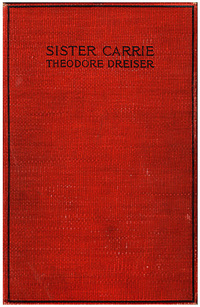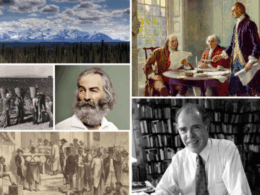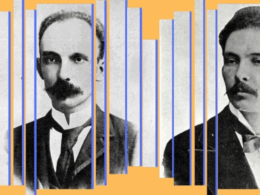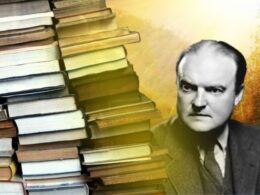Guest blog post by Anne Trubek, critic, blogger, and author of A Skeptic’s Guide to Writers’ Houses

If you read the critical literature, Theodore Dreiser is one giant American cliché. He is boorish, and dull, and a poor stylist (“rhetorical bungling” is how Sandy Petrey put it); he is self-made, and crude. Dreiser has “the awkwardness, the chaos, the heaviness which we associate with reality,” Lionel Trilling said. Critics who champion him do so because “dullness and stupidity must naturally suggest a virtuous democracy” (Trilling again). You get to imagining Dreiser as some American golem, made from native mud.
His best novel, Sister Carrie, comes a respectable thirty-third on the Modern Library’s list of the 100 best. When Sinclair Lewis accepted his Nobel Prize in 1930, he said that Dreiser, “marching alone, usually unappreciated, often hated, [had] cleared the trail from Victorian and Howellsian timidity and gentility in American fiction to honesty and boldness and passion of life. Without his pioneering, I doubt if any of us could, unless we liked to be sent to jail, seek to express life and beauty and terror.” Even when championed, he is our pure product.
And you have to admit Sister Carrie has it all. It is about the rise of a fallen woman, and Carrie’s upward quest takes us through low-wage factory jobs, life as the mistress of a traveling salesman, accomplice to theft, life in New York as a chorus girl, strikes, strikebreakers, celebrity and suicide. The novel’s troubled publishing history illustrates how provocative it was for its time. Women who lose their virtue were to be punished or killed. For Dreiser’s publisher, Doubleday, Page & Co., and by extension the American reading public, it was all too much, too much America and bad faith.
The first person to read the novel at Doubleday was Frank Norris, another young realist, who had just published his first novel, McTeague. Norris enthusiastically recommended Sister Carrie for publication. After a senior editor read and liked the book as well, Walter Page sent Dreiser an encouraging note—“we are very much pleased with your novel”—and invited him to a meeting. Dreiser left with the understanding that his novel would be published that fall, in 1900, although no contract was signed. A few weeks later, Frank Doubleday, the senior partner, returned from a European trip and shortly thereafter the firm’s interest began to lag. One story has Doubleday shocked by Sister Carrie’s seamy depiction of urban life. Another holds that Doubleday’s wife strongly objected to the book.
Doubleday tried to renege on the agreement but relented after Dreiser agreed to change most of the real names in the book and tone down a few sexually explicit passages. One thousand copies were printed, and only 456 sold. The only copies reviewers received were those sent by Norris himself. Dreiser claimed that Doubleday only published Sister Carrie to avoid a lawsuit. Its plain red cover seemed designed to attract as little attention as possible.
Yet Dreiser knew he had tapped into something powerful, something beyond himself, the “national unconscious,” as it were. He even claimed he had nothing to do with the book. On starting to write it, he said: “My mind was a blank except for the name. I had no idea who or what she was to be. I have often thought there was something mystic about it, as if I were being used, like a medium.” On writing the ending he said that he went to the Palisades in New Jersey and, relaxing on a cliff, spent two hours in “a delicious mental drifting. Then suddenly came the inspiration of its own accord. I reached for my notebook and pencil and wrote. And when I left the Palisades Sister Carrie was completed.” He’s the romantic author recollecting in tranquility, but he’s recollecting national longing, not his own.
Ah, but Dreiser the businessman? He was all about taking control and acting in self-interest. After the Doubleday debacle, he bought the book’s plates, negotiated contracts, and became a stockholder in the publisher who finally brought it out in 1907. The initial printing of three thousand copies sold out in ten days. Then in 1914, he offered the original, pencil-written manuscript to H. L. Mencken, his friend and literary advocate. Mencken replied that he would relish the manuscript “more than the gift of a young virgin.” Years later, in 1943, Dreiser and Mencken would correspond about the manuscript’s preservation. Mencken wrote:
In New York the other day I dropped in at the public library to see what had been done with the manuscript of Sister Carrie. I had not seen it since it was mounted. These few lines are simply to say that I was genuinely astounded. Lydenberg and his goons did a really magnificent job. The manuscript is beautifully mounted, covered with Japanese tissue and bound in four volumes with the loveliest leather I have seen for years. Each volume is also in a leather box. It is kept in the manuscript vault under the city level and no one can see it without an order from you or me.
Dreiser responded:
It was nice of you to send me your word picture of the Carrie ms. sleeping so royally and peacefully in the subterranean vault of the New York Public Library. What grandeur after her long and poverty stricken beginning! And how pleasant it would be to track down into that royal sanctuary with you and, hat in hand, gaze humbly—maybe, who knows, even genuflect! One can never trust these literary moods that sweep over one on occasion…Well, darling, please thank Dr. Lydenberg for me for his—what shall I call it? Courtesy? Reverence? Sympathy for that once so bedraggled maid.
Ack! What silly romanticism from our paradigmatic naturalist. And our rough and tumble novel in a Japanese tissue? He is the penitent praying and he is God, looking down upon his immaculately conceived virgin.
Today, Dreiser is known but, I suspect, not often read. I will admit he can be a chore, with those long digressions and weird Spenserian musing. Sure, he crams in too much. But he gets it, doesn’t he? How could he not, being us and all? A big gloomy Golem, a fulsome American tragedy.



